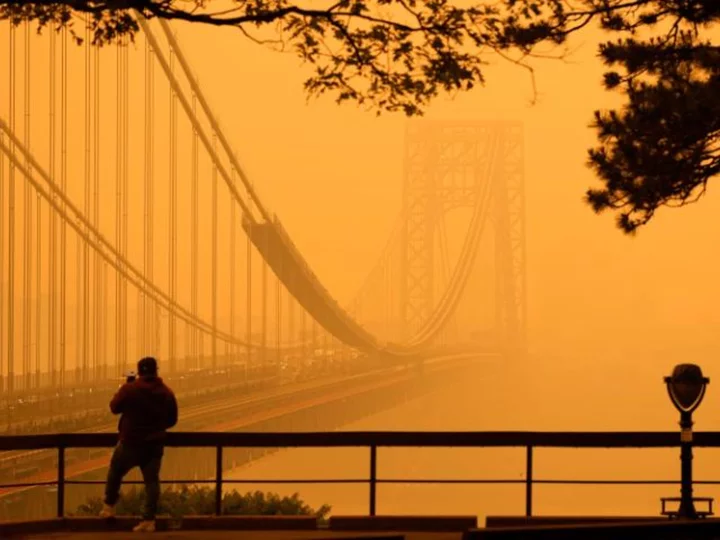Avni Pravin did not have asthma growing up.
But at the age of 30, Pravin says she now has trouble breathing. While she has not yet been officially diagnosed with asthma, she said her doctor has prescribed her an inhaler.
"The reason I felt so affected earlier (was because) being outside, (I felt) that familiar tightness in my chest," Pravin, a deputy director for Alliance for a Green Economy, told CNN on Thursday after speaking at a rally in Manhattan with other climate activists under the backdrop of New York's hazy skies. "There were lots of folks who were walking from construction jobs and just day-to-day activities that they can't avoid."
"I just was really having this moment of feeling extremely fed up with legislators that don't want to take action," she added.
As wildfires in Canada continue to push toxic smoke toward the eastern US, environmental justice activists in New York are pleading for their state lawmakers to pass climate change legislation that would essentially limit new methane gas hookups. This week's hazardous air is only exacerbating health risks in vulnerable Black and brown communities, activists say.
The dangerous air conditions are expected to slowly improve heading into the weekend for millions of people in New York, Washington, DC, and surrounding areas.
But for many Black and brown people in low-income communities, activists say air pollution is a problem they already face every day.
People of color are disproportionately exposed to air pollution from industry, gas-powered vehicles, construction and other sources, according to a 2021 study that analyzed government air pollution and census data.
In a separate study, researchers found that Black people breathe 56% more pollution than they cause, whereas White people breathe 17% less population than they make — underscoring the dire environmental disparity that exists across marginalized groups.
Victoria Sanders, a research analyst for the NYC Environmental Justice Alliance, said her organization is encouraging residents to wear masks and avoid going outside, however, she understands that many New Yorkers work front line, essential jobs. And research shows that Black and Latino Americans are overrepresented in essential jobs, such as warehouse workers.
Many Black Americans also have pre-existing conditions related to poor air quality such as asthma, cardiovascular, respiratory and pulmonary issues, Sanders said.
Asthma emergency room visits for adults and children are the highest in the New York neighborhoods of East Harlem, South Bronx and Central Harlem, with East Harlem up to 18 times higher than the richer, more predominantly White neighborhood of Greenwich Village, according to data from the New York health department.
Asthma rates are also the highest in these same neighborhoods, as well as parts of Brooklyn, where Pravin lives.
"We have a lot of Black and brown communities that are surrounded by power plants ... large highways with a lot of traffic," Sanders said. "So there is a lot of polluting infrastructure that has been interwoven into these communities and pushed into these communities so that wealthier communities wouldn't have to deal with those issues."
In the South Bronx, a predominantly low-income neighborhood of color, residents see an annual average of 11 to 13 micrograms per cubic meter of fine particulate matter, or PM 2.5, which is higher than the World Health Organization's air quality guideline of just 5 micrograms. That same area also sees the city's highest rate of emergency care visits for asthma as well as respiratory hospitalizations.
"Climate change has led to drier conditions that make for a longer and more active wildfire fire season, and the smoke from these fires can contribute to a wide variety of adverse health impacts, from difficulty breathing and reduced lung function to heart attacks and even premature death," Annie Carforo, climate justice campaigns manager at WE ACT for Environmental Justice, told CNN. "These are the same health issues we see from burning fossil fuels, such as natural gas, but many overlook or downplay this threat because you cannot see or smell this pollution as easily as you can with wildfire smoke."
"And the cumulative impacts of all of this pollution does greater harm to people of color, especially Black (people), as studies indicate that they are exposed to higher amounts of air pollution," she added.
Meanwhile, in Pravin's Brooklyn neighborhood of Bushwick, she and other climate activists have been fighting against a natural gas pipeline that they say would bring more environmental and climate harms their way.
Methane, the main component of natural gas used to fuel stoves and heat homes, has more than 80 times as much warming power as carbon dioxide in the first two decades it's in the atmosphere. For that reason, scientists have narrowed in on slashing fossil fuels as a way to rapidly decrease planet-warming pollution. Several studies also have found that gas stoves are responsible for severe health conditions, including asthma.
The wildfire smoke only adds to these underlying burdens, and it's just among the most visible examples of those harms if the planet continues to warm.
"This is such a wakeup call for people around the city," Pravin said. "But for some folks that deal with respiratory disorders 24/7 year-round, or live in poorly ventilated housing, or deal with mold and asbestos in their homes, this is what they experience day to day."

